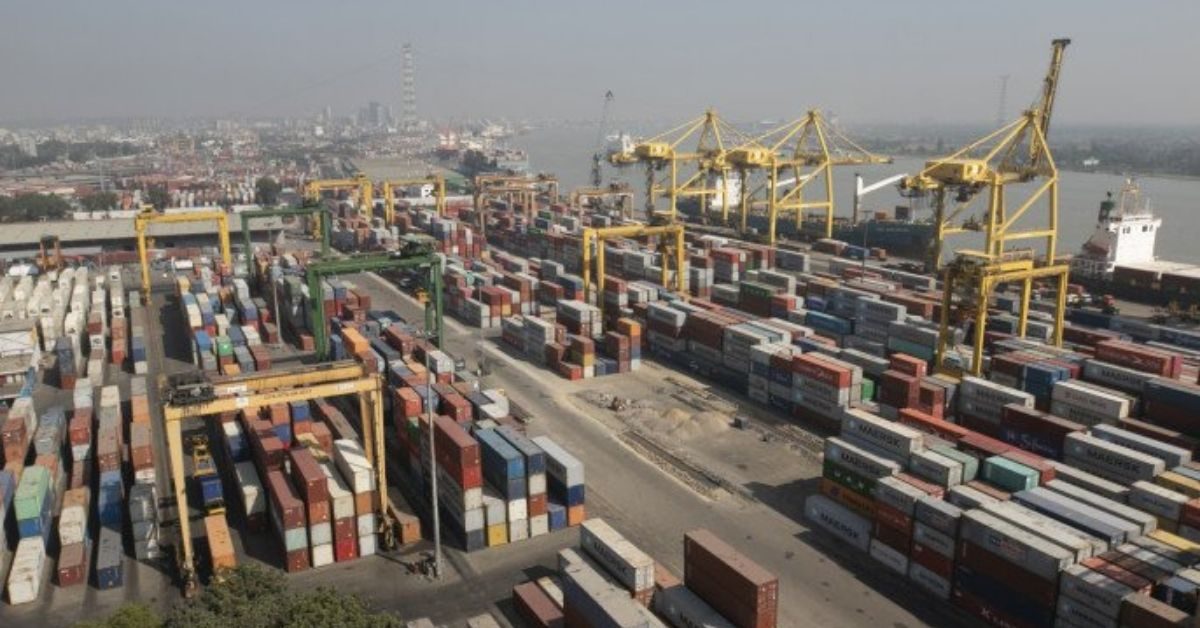Shipping cost at Chattogram port is going to come down by about 40% as a fully dredged Karnaphuli River will allow 10-metre draught vessels to berth at the port from next month, which will speed up handling of containers.
At present, ships with a maximum draught of 9.5m can anchor at the port, carrying around 1,500-2,000 containers at one go, according to people concerned.
But, once a project to dredge a four-kilometre stretch of the Karnaphuli near the port, which has achieved 93% progress so far, is complete, 10-metre-draught vessels, capable of carrying around 2,500-3,000 containers each at a time, will be able to berth at the port, they added.
Syed Iqbal Shimul, senior vice-president of the Bangladesh Shipping Agents Association, said, “The container volume will double if ships with a draught of 10 metres and a length of 200 metres arrive at the port.
“As a result, the transportation cost of a 40-foot container will drop to $5,000 from $8,000. And the cost of a 20-foot container will come down to $2,500 from $4,000.”
This will reduce import-export costs, he observed.
Omar Farooq, secretary of Chattogram Port Authority, said, “A British consulting firm is working on these issues. Ships with a draught of 10 metres will be allowed to enter the jetty after their reports are received next month.”
So far, 46 lakh cubic metres of waste, of which 50% is plastic and polythene, have been removed from the four-kilometre area by using special dredging machines.
The dredging project was undertaken in 2011 to increase the navigability of the river. The project cost was initially estimated at Tk229 crore.
According to sources, initially, the dredging work was conducted by the Malaysian Maritime and Dredging Corporation (MMDC). But the company left the country without finishing the work.
The authorities then cancelled the agreement with the company in 2014 and were involved in a legal battle with the company for five years. In 2018, the project was undertaken anew with E-Engineering, a sister concern of Saif Powertech.
The project cost was also increased to Tk321 crore with a target of extracting 51 lakh cubic metres of waste from Sadarghat to Bakliar Char areas of the river.
Md Saiful Islam, project manager of E-Engineering, told The Business Standard, “The work was very challenging. At first, the dredgers were not working because the pile of waste was solid. There was everything in the base of the Karnaphuli – plastic, polythene, cloth, wood, tree bark, iron, etc.”
“We used 20-25 bulk carriers and more than 10 graft dredgers for this work. After removing the waste, we excavated the soil with dredgers. The soil has been dumped in different places, including Bakliar Char, Bastuhara, Firingibazar, Chaktaikhal, and on the north side of Shah Amanat Bridge.
“Siltation of the river posed another challenge. After we extracted the soil of a place, it was being filled with the soil from the surrounding area. Due to this, dredging has had to be done several times in the same place.”
Dredging will continue as part of regular maintenance until 2025, he further said.
Commander M Arifur Rahman, director of Capital Dredging Project and chief hydrographer of Chattogram Port Authority, said, “The traditional dredging method did not work here as there was a layer of waste on top of the soil and sand. After consulting with Buet experts, we first determined where the piles of dirt were. We used an echo finder device and other methods to determine the depth of the layer of the waste.”
“Out of the total 51 lakh cubic metres of waste, 25-27 lakh cubic metres were solid waste, including plastic, polythene, rubber. Around 85%-90% of the waste was lifted from the front section of Chaktai-Rajakhali canal. The capital dredging work will be completed this month. After that, maintenance dredging work will continue till 2025,” he added.
Currently, this city of about 70 lakh people generates about 40 crore litres of sewage and three lakh litres of domestic waste daily which go to the river through 51 canals.
Apart from this, several hundred tonnes of industrial waste also go into the river. Moreover, during the rainy season, about 10 lakh tonnes of silt fall into this river every day with rainwater.
Meanwhile, Dr Md Shafiqul Islam, professor of the Institute of Marine Sciences, Chattogram University, told TBS that the dredging project has damaged some species, especially slow-moving animals such as annelids, snails, etc, living in the Karnaphuli.
“There are also endangered dolphins in the river. We suggested the authorities keep the mouths of different channels open as dolphins collect food from these places.”
People concerned said Chattogram port has three terminals – New Mooring Container Terminal (NCT), Chattogram Container Terminal (CCT), and General Cargo Berth (GCB). Among them, ships with 10 metres draught will go to NCT and CCT following the completion of the dredging work. Besides, the construction of Patenga Container Terminal with four berths has also been completed. The trial operation of this terminal will begin on 21 July, they said.







